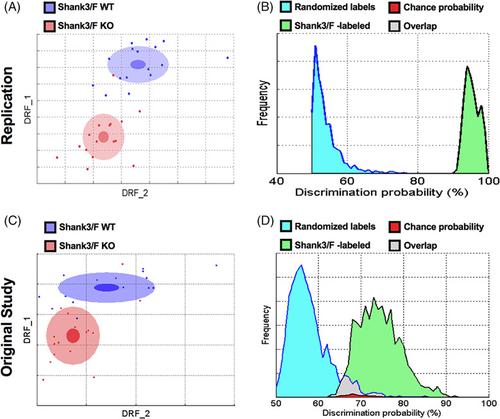当前位置:
X-MOL 学术
›
Genes Brain Behav.
›
论文详情
Our official English website, www.x-mol.net, welcomes your feedback! (Note: you will need to create a separate account there.)
Mouse model systems of autism spectrum disorder: Replicability and informatics signature.
Genes, Brain and Behavior ( IF 2.5 ) Pub Date : 2020-05-22 , DOI: 10.1111/gbb.12676 Patricia Kabitzke 1, 2 , Diana Morales 1, 3 , Dansha He 1 , Kimberly Cox 1 , Jane Sutphen 1, 4 , Lucinda Thiede 1, 5 , Emily Sabath 1, 6 , Taleen Hanania 1 , Barbara Biemans 7 , Daniela Brunner 1, 8
Genes, Brain and Behavior ( IF 2.5 ) Pub Date : 2020-05-22 , DOI: 10.1111/gbb.12676 Patricia Kabitzke 1, 2 , Diana Morales 1, 3 , Dansha He 1 , Kimberly Cox 1 , Jane Sutphen 1, 4 , Lucinda Thiede 1, 5 , Emily Sabath 1, 6 , Taleen Hanania 1 , Barbara Biemans 7 , Daniela Brunner 1, 8
Affiliation

|
Phenotyping mouse model systems of human disease has proven to be a difficult task, with frequent poor inter‐ and intra‐laboratory replicability, particularly in behavioral domains such as social and cognitive function. However, establishing robust animal model systems with strong construct validity is of fundamental importance as they are central tools for understanding disease pathophysiology and developing therapeutics. To complete our studies of mouse model systems relevant to autism spectrum disorder (ASD), we present a replication of the main findings from our two published studies of five genetic mouse model systems of ASD. To assess the intra‐laboratory robustness of previous results, we chose the two model systems that showed the greatest phenotypic differences, the Shank3/F and Cntnap2, and repeated assessments of general health, activity and social behavior. We additionally explored all five model systems in the same framework, comparing all results obtained in this three‐yearlong effort using informatics techniques to assess commonalities and differences. Our results showed high intra‐laboratory replicability of results, even for those with effect sizes that were not particularly large, suggesting that discrepancies in the literature may be dependent on subtle but pivotal differences in testing conditions, housing enrichment, or background strains and less so on the variability of the behavioral phenotypes. The overall informatics analysis suggests that in our behavioral assays we can separate the set of tested mouse model system into two main classes that in some aspects lie on opposite ends of the behavioral spectrum, supporting the view that autism is not a unitary concept.
中文翻译:

自闭症谱系障碍的小鼠模型系统:可复制性和信息学签名。
对人类疾病进行小鼠表型分型已被证明是一项艰巨的任务,实验室间和实验室内的可复制性经常很差,尤其是在诸如社交和认知功能等行为领域。但是,建立具有强大构建效度的健壮动物模型系统至关重要,因为它们是了解疾病病理生理学和开发治疗方法的重要工具。为了完成对与自闭症谱系障碍(ASD)相关的小鼠模型系统的研究,我们提供了来自我们对五个ASD遗传小鼠模型系统的两项已发表研究的主要发现的重复。为了评估先前结果在实验室内的稳健性,我们选择了表现出最大表型差异的两个模型系统Shank3 / F和Cntnap2,并对一般健康状况,活动和社交行为进行反复评估。此外,我们在相同的框架中探索了所有五个模型系统,使用信息学技术评估了共同点和差异,比较了这一为期三年的努力所获得的所有结果。我们的结果表明,即使在效应大小不是特别大的实验室中,结果也具有很高的实验室可复制性,这表明文献中的差异可能取决于测试条件,住房富集或背景菌株的细微但关键的差异,而差异较小。行为表型的变异性。整体信息学分析表明,在我们的行为分析中,我们可以将一组经过测试的小鼠模型系统分为两大类,在某些方面它们位于行为谱的相对两端,
更新日期:2020-05-22
中文翻译:

自闭症谱系障碍的小鼠模型系统:可复制性和信息学签名。
对人类疾病进行小鼠表型分型已被证明是一项艰巨的任务,实验室间和实验室内的可复制性经常很差,尤其是在诸如社交和认知功能等行为领域。但是,建立具有强大构建效度的健壮动物模型系统至关重要,因为它们是了解疾病病理生理学和开发治疗方法的重要工具。为了完成对与自闭症谱系障碍(ASD)相关的小鼠模型系统的研究,我们提供了来自我们对五个ASD遗传小鼠模型系统的两项已发表研究的主要发现的重复。为了评估先前结果在实验室内的稳健性,我们选择了表现出最大表型差异的两个模型系统Shank3 / F和Cntnap2,并对一般健康状况,活动和社交行为进行反复评估。此外,我们在相同的框架中探索了所有五个模型系统,使用信息学技术评估了共同点和差异,比较了这一为期三年的努力所获得的所有结果。我们的结果表明,即使在效应大小不是特别大的实验室中,结果也具有很高的实验室可复制性,这表明文献中的差异可能取决于测试条件,住房富集或背景菌株的细微但关键的差异,而差异较小。行为表型的变异性。整体信息学分析表明,在我们的行为分析中,我们可以将一组经过测试的小鼠模型系统分为两大类,在某些方面它们位于行为谱的相对两端,


























 京公网安备 11010802027423号
京公网安备 11010802027423号